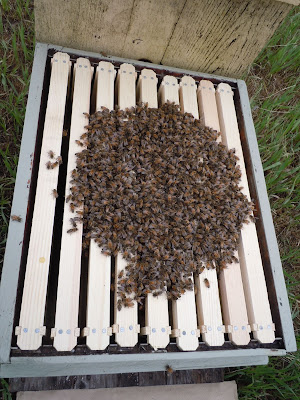This weekend, two of our hives swarmed. I walked out of the house on saturday morning and instantly heard them. Walking over by the hives there were bees everywere. Hives swarm for several reasons, but it usually comes down to either the bees are healthy and reproducing, or they are leaving to find a new location. The good news for us is that these swarms belong to the first group. I know that because while the swarms were forming, the parent hive continued on with business. In the picture below, you can see the two swarms: one in front of me and one on the far left (below the farthest hive). Beekeepers try to reduce swarming because it means a loss of population and a reduction in potential pollination and honey. But on the other hand, if your hives are healthy enough to swarm, then you are doing something right and the bees are doing what they naturally want to do: Reproduce! So I take it as a good sign. In the book Natual Beekeeping, the author Ross Conrad refers to swarming as "the miracle of life" since it really is bee reproduction.
So, now what to do about this rampant reproduction. My first idea was to simply place hive boxes near the swarms and allow them to hive themselves. This is a technique that some swear by, so I thought I'd give it a try. But after leaving them there for several hours, the bees had yet to move into the boxes so I decided to catch them manually.
Here is a good look at one of the swarms. The bees leave the colony and ball around the queen. While they are in the ball, scouts are out searching for a new home. The scouts could return at any time and communicate to the swarm it was time to leave, so I decided to hive them before they had a chance to leave. I have read that bees will remain balled for as little as fifteen minutes, and these had already been here for several hours.
When you are hiving a swarm, you physically take the swarm and place them into the hive. The sensation of picking up the bees is pretty amazing, they feel like a warm spongy mass of about a couple of pounds. The most important thing is to make sure you get the queen. Here (above) on my finger tips you can see the queen of one of the swarms. Once the queen is secure in the new hive, all the workers follow her right in, guided by her pheromones.
Here is a swarm placed into the new hive. This is the deep box that I had prepared in case I got a chance to catch a swarm this summer. The other swarm got placed into a super ( or medium box) because I don't have any other deep boxes on hand. This will work just fine, but will require more equipment because I'll have to give them two supers to equal one deep box.
So here we are this evening. I successfully captured both swarms, upping our count to five colonies! I'm glad that I didn't lose any of my bees, but I need to get better at anticipating and preventing swarming. In the mean time I need to get to work building frames so that all these bees have somewhere to store their honey! More on that later.
KJ





2 comments:
Another bold step taken to preserve honey bee colonies (and increase your budding cash crop). Good job, Kyle!
Five colonies?! Man, you guys don't do anything half way do you? 30+ chickens, what? 10 veggies beds, and now 5 bee colonies? Just teasing -- you know I am green with envy over your little homestead. :) Wish we could have bees. I keep bringing it up, and it scares Joe (he's allergic). Personally I think the neighbors roof over her garage would be so perfect -- it is perfectly flat unused space. But how do you approach someone and say, "Could I keep a few thousand bees on your roof?"
Post a Comment